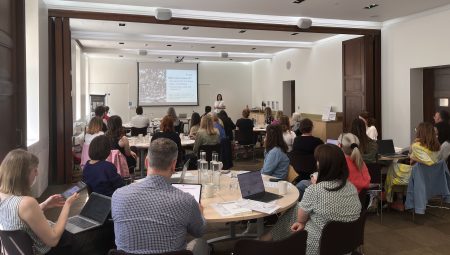 The CLOSER Longitudinal Communications Network (LCN) conference, held in May, brought together colleagues from across the UK longitudinal population study community for a day of learning, networking, and collaboration.
The CLOSER Longitudinal Communications Network (LCN) conference, held in May, brought together colleagues from across the UK longitudinal population study community for a day of learning, networking, and collaboration.
This was a space for focussed discussions on the critical challenges facing LCN Members through a co-produced agenda. Our keynote speaker, Dr Sarah Bunn, Head of the UK Parliament’s Science, Digital & Technology Hub, and workshop speakers, provided valuable insights into how studies can engage with the scrutiny process, better communicate with diverse audiences, and demonstrate the impact of their methodological work.
Engaging effectively with Parliament
Dr Bunn’s keynote highlighted the diverse landscape of research users within the UK Parliament, from individual MPs and Peers to Select Committees and parliamentary staff. She emphasised that parliamentarians conceptualise “evidence” and “research” broadly as knowledge, encompassing not just academic research but also constituency information, lived experience, and legal insights.
Key opportunities for engagement include working with Select Committees on relevant inquiries, connecting with the Parliamentary Office of Science and Technology (POST), and exploring fellowship opportunities. Dr Bunn stressed that Parliament values and welcomes evidence from researchers, encouraging the longitudinal research community to improve communication skills, explain research clearly to non-specialists, and actively seek opportunities to engage with policymakers.
The presentation underscored that effective parliamentary engagement can shape policy agendas, provide demonstrable research impact, and offer new perspectives that inform future research questions shaped by real-world policy challenges.
Engaging with data users: strategies for reaching new audiences
The session on engaging with data users revealed the ongoing challenge of effectively communicating the breadth of study data to new users. Participants shared diverse approaches and innovative solutions for making longitudinal data more accessible and discoverable.
Social media emerged as a crucial tool, with LinkedIn proving particularly effective for highlighting data releases and underused datasets. However, participants emphasised the importance of using multiple platforms, as different user groups are now in different digital spaces and communicate differently across platforms.
The development of research seminar series targeting early career researchers was highlighted as a successful approach, with participants noting the importance of providing both thematic pathways and experience-level guidance. This dual approach helps users navigate data more effectively based on their research interests and technical capabilities.
The power of personal connection
Word-of-mouth promotion and supportive relationships proved invaluable, with the concept of providing ‘data buddies’ to help users work with and understand datasets gaining particular attention. This personal touch addresses the often intimidating nature of large-scale longitudinal datasets for new users.
Participants also emphasised the significant influence supervisors have over students’ and early career researchers’ data choices, though they noted that supervisors currently lack a clear ‘point of entry’ as a group – highlighting an important opportunity for targeted outreach.
Innovative approaches to data discovery
Several creative solutions emerged for improving data discoverability. Participants discussed implementing ‘have you also looked for this?’ prompts during data searches, similar to recommendation systems used by commercial platforms. The development of data visualisation tools that present content overviews in user-friendly, multi-device compatible formats was seen as increasingly important.
AI integration was also explored as a potential solution, though participants stressed these are enhancement tools and there remains the need for additional checks to ensure accuracy. The creation of shared resources that can pull data across multiple studies when policy interests are identified could help expedite research and reduce burden on individual studies.
Showcasing impact and lesser-used data
Participants grappled with the challenge of promoting underused data in their studies. They highlighted the effectiveness of mini-campaigns for raising awareness of key initiatives or lesser-known data types. The promotion of research case studies across platforms that showcase interesting or underused data types also can help inspire researchers with possibilities they might not have considered.
However, participants acknowledged the difficulty in defining what constitutes ‘not as well used’ data, noting the challenge of determining market size for certain data types. The focus shifted toward showcasing what data can solve rather than simply describing what it contains, with case studies proving particularly powerful to achieve this.
Communicating the impact of survey methods
Innovative experiences and strategies were shared, illustrating how to make technical methodological work more accessible and demonstrate its value — despite the ongoing challenge of highlighting the impact of survey methods work, both to funders and the broader research community.
A recurring theme was the difficulty of getting researchers and academics to communicate survey methods in simple language. This challenge extends beyond individual studies to the broader issue of making survey methodology accessible to diverse audiences with varying levels of technical expertise. The ‘mobilise your research’ section of our Training Hub aims to address this imbalance with detailed guidance on writing for different audiences and platforms, including: creating blogs, using infographics to bring research to life, and engaging with policymakers.
Looking forward
The discussions throughout the day highlighted both the challenges and opportunities facing members of the longitudinal communications network. The emphasis on personal relationships, multi-platform strategies, and tailored communication approaches provides a roadmap for more effective engagement with audiences. Meanwhile, the ongoing work to make survey methods more accessible and demonstrable to funders remains a critical priority for the sustainability and growth of longitudinal research.
The collaborative spirit evident in these discussions, with participants freely sharing both successes and ongoing challenges, exemplifies the value of bringing together this community for focused, practical conversations about the real-world challenges they face in their communications work and how we can work together to drive forward innovations on our path to excellence.
I’d like to end this piece by thanking all the LCN participants and conference speakers who contributed their valuable insights and expertise at this event.
